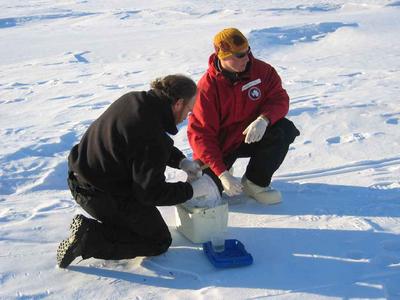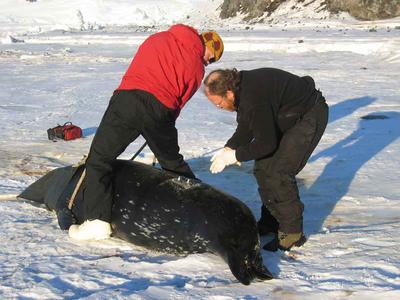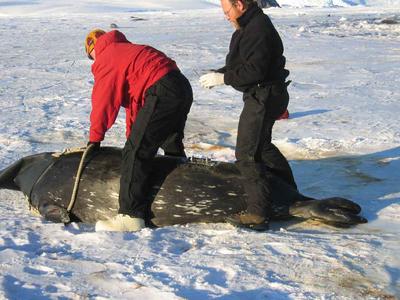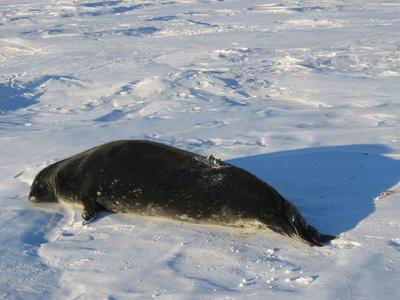
|
|
19 November, 2003
Today we had a change in camp personnel. Dr. Brent Stewart left to
return to California. His bunk was immediately filled by Dr. Robert
Garrott, our project's PI, who arrived from Bozeman, Montana. Dr.
Garrott will be here through the end of our field season.
Somehow, in all this journalizing, I never got around to profiling
Brent. He has been collaborating with the Weddell Seal Project since
1996, and works with the Hubbs-Sea World Research Institute in San
Diego as a Senior Research Biologist. Brent has studied the
population biology, foraging and physiological ecology, and behavior
of marine mammals and sea birds for over 25 years. His research
expeditions have ranged from Greenland and Iceland in the North
Atlantic south to Marion Island in the South Atlantic and Indian
Ocean, in Russia's Lake Baikal, from the Beaufort and Bering Seas
south through temperate, tropical and equatorial waters in the North
Pacific Ocean, and in the Weddell, Amundsen, and Ross Seas of the
Antarctic's Southern Ocean. His principal interests in these
comparative studies has been discovering and understanding what
habitats are important to these various large marine vertebrates, how
they navigate and migrate over vast areas to find and use those
habitats, how they hunt and capture prey necessary to sustain fasting
periods and successfully reproduce, how they interact with each other
(populations and species) while sharing habitats and resources, and
how they respond and adjust to short and long term natural and
anthropogenic changes in those key habitats.
When asked how he ended up as a globe-trotting marine mammal
researcher, Brent responded this way. "I didn't start out with any
plan to study marine mammals. In college I studied math, philosophy,
English literature, music, and biology though exploration of wild,
remote unvisited and unknown places. This was, I think, my key
passion. A simple twist of fate led to a Master of Science program
studying marine invertebrates, interrupted by a few unexpected
disasters and another simple twist of fate found me training dolphins
to help a friend with her Masters thesis. Somehow that all led to a
25+ year career as a field biologist exploring remote romantic places
on this planet and studying various marine vertebrates, mostly marine
mammals, that live in those wild and wonderful places....and earning
a couple more graduate degrees in rather unorthodox ways along the
trail. But mostly, I'm not really sure how it all got started and
not too sure where it might be going. It's been a vagabond life, but
I sure hope a lot of others can be so fortunate. Pitching up in the
Antarctic surely is glorious. Though some might consider it the
geography of despair because of how poorly adapted humans might be to
live there, it might really be considered the geography of hope, as
Wallace Stegner referred to another remarkable landscape, the
American West."
Brent and his wife Dr. Pamela Yochem, a wildlife veterinarian, have
been collaborating with this project since 1996. They will both
return to Antarctica in January to continue their work on this
project. In their work they are trying to supplement the long-term
population biology research by applying remote sensing technology to
document where Weddell Seals spend their time in the water column and
geographically as they search for, and capture, prey. Small
microcomputers called TDRs (time-depth recorders) that they glue to a
seal's hair store measurements of hydrostatic pressure (converted to
depth) every 5 to 15 seconds. This sampling interval is programmed
before the microcomputer is attached. At that rate they can record
the vertical location of a seal continuously for up to 8 months. The
glue mounts fall off the seals when they molt in January and
February. They have to recover these recorders to transfer the data
by searching the colonies at various times to find, capture, and then
unfasten the recorders from those glue mounts. The recovered data
tells them what vertical habitats are key to seal foraging efforts
and if these habitat preferences vary among colonies and between
males and females of different ages. The TDRs also give them an
index of the amount of effort that seals spend to forage because they
can determine the timing and number of dives as well as their
duration. In addition, they use satellite-linked radio transmitters
to tell them where seals are geographically when diving and foraging.
Those locations are sent to his email account daily as long as the
few earth-orbiting satellites are detecting signals from the
transmitters attached to the seals. Brent and Pamela are also
evaluating the health of seals, using standard analyses of blood
samples and veterinary medical inspections, to determine what kinds
of infectious diseases the seals have previously been exposed to or
may be suffering from now. Animals in poor health may be less
capable or efficient at diving and foraging. This may translate into
poorer survival or inability to reproduce as often. These effects
may help explain patterns seen in the long-term demographic study.
Brent has an impressive roster of upcoming projects that will take
him from the Channel Islands studying Elephant Seals, to Baja doing
Grey Whale surveys, and on to Australia for a project looking at
Whale Sharks. He is definitely seeing the world, one marine mammal
at a time.
Daily Haiku:
Weddell Seals dive
How far, how long, where are they?
TDR info

Brent and Darren mix epoxy that will be used to glue the TDR to a seal.

Darren steadies the seal, while Brent applies epoxy to the patch that will hold the TDR to its fur.

The epoxy needs about 5 minutes to set before the seal is released.

Here's the seal with the TDR attached and ready to go.
Contact the TEA in the field at
.
If you cannot connect through your browser, copy the
TEA's e-mail address in the "To:" line of
your favorite e-mail package.
|
